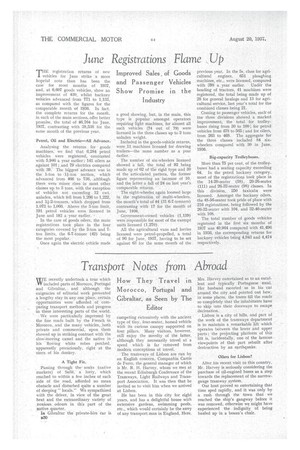June Registrations Flame Up
Page 40

If you've noticed an error in this article please click here to report it so we can fix it.
Improved Sales. of Goods and Passenger Vehicles Show Promise in the Industry
it:Iregistration returns of new des for June strike •a more hopeful note than has been the case for most months of 1937, and, at 6,607 goods vehicles, show an improvement of 430, whilst hackney vehicles advanced from 771 to 1,133, as compared with the figures for the comparable month of 1936. In fact, the complete returns for the month, in each of the main sections, offer better promise, the total of 46,764 for June, 1937, contrasting with 38,536 for the same month of the previous year.
.Petrol, Oil and Electric—All Advance.
Analysing the returns for goods machines, we find that 6,284 petrol vehicles were registered, contrasted with 5,946 a year earlier ; 141 oilers as against 101; and 79 electrics compared with 39: The biggest advance was in the 1-ton to • 1i-ton section, which advanced from 466 to 736, altlfough there were minor rises in most other classes up to 3 tons, with the exception of vehicles not exceeding 12 cwt. unladen, which fell from 1,266 to 1,222, and 14-2-toriners, which dropped from 1,073 to 1,066. Above the 3-ton limit, 191 petrol vehicles were licensed in June and 182 a year earlier. • In the case of goods oilers, the main registrations took place in the four categories covered by the 3-ton and 7ton limits, the 6-7-tonner (42) being the most popular.
Once again the electric vehicle made
a good showing, but, in the main, this type is popular amongst operators requiring light machines, for almost all such vehicles (74 out of 79) were -licensed in the three classes up to 2 tons. unladen weight.
Included in the goods-vehicle returns, were 11 machines licensed for drawing trailers—the same number as a year earlier.
The number of six-wheelers licensed showed a fall, the total of 92 being made up of 62 of the rigid type and 30 of the articulated pattern, the former figure representing an increase of 10, and the latter a fall of 24 on last year's comparable returns.
The eight-wheeler again loomed large in the registration of multi-wheelers, the month's total of 44 (31 6-7-tonners) contrasting with 17 for the month of June, 1936, Government-owned vehicles (1,139) were responsible for most of the exempt units licensed (1,270).
All the agricultural vans and lorries licensed were petrol-propelled, a total of 90 for June, 1937, having to be set against 63 for the same month of the previous year. In the 5s. class for agricultural engines, 651 ploughing machines, etc., were licensed, compared with at8 a year earlier. Under the heading of tractors, 41 machines were registered, the total being made up of 28 for general haulage and IS for agricultural service, last year's total for the combined classes being 21.
Coming to passenger vehicles, each' of toe three divisions showed a marked improvement, the total for trolleybuses rising from 30 to 100 ; for petrol vehicles from 478 to 505; and for oilers, from 263 to 468. The aggregate for the three classes included 84 Six'. wheelers conipared with 30 in June, 1936.
Big-capacity Trolleybuses.
More than 75 per cent, of the trolleybuses had a seating capacity exceeding 64. In the petrol hackney category, most of the registrations took place in the 14-20-seater (58), 20-26-seater (111) and 26-32-seater (98) Classes. In this division, 250 taxicabs were licensed. Amongst the hackney oilers, the 48-56-seater took pride of place with 216 registrations, being followed by the 26-32-seater with 104, and 32-40-seater with 108.
The total number of goods vehicles registered in the first six months of 1937 was 40,964 compared with 41,496 in 1936, the corresponding returns for hackney vehicles being 4,943 and 4,474 respectively.




















































































